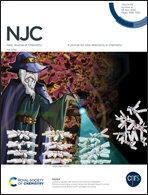Heterobimetallic cyanide-bridged FeIII(μ-CN)MII complexes (M = Mn and Cu): synthesis, structure and magnetism†
Abstract
A controlled reaction in DMF/CH3CN between a facially disposed tricyanide-containing building block (nBu4N)[FeIII(Tp)(CN)3] (Tp(–) = tris(pyrazol-1-yl)borate anion) and tailor-made Mn(II) and Cu(II) complexes of two tripodal tetradentate ligands providing two 1-methylbenzimidazole, a pyridyl, and a tertiary amine as donor sites, differing only in the (2-pyridyl)alkylamine chain length, has been employed to assemble cyanide-bridged complexes. The heterobimetallic complexes [FeIII(Tp)(CN)2(μ-CN)MnIICl(L1)]·3DMF·3H2O (1), [FeIII(Tp)(CN)2(μ-CN)MnIICl(L2)]·DMF (2), [FeIII(Tp)(CN)2(μ-CN)CuII(L1)](ClO4)·2CH3OH (3), and [FeIII(Tp)(CN)2(μ-CN)CuII(L2)](ClO4)·2CH3CN (4) [L1 = bis{(N-methyl-benzimidazol-2-yl)methyl}(2-pyridylmethyl)amine; L2 = bis{(N-methyl-benzimidazol-2-yl)methyl}(2-pyridylethyl)amine (L2)] have been structurally authenticated, revealing single cyanide-bridged discrete dimers with Fe(III)(μ-CN)Mn(II) and Fe(III)(μ-CN)Cu(II) structural motifs. In 1 and 2, both the metal ions have a distorted octahedral geometry. In 3 and 4, the Fe(III) centres are six-coordinate, but the two five-coordinate Cu(II) centres assume two different geometries: distorted trigonal bipyramidal in 3 and almost ideal square pyramidal in 4. Investigation of the magnetic properties reveals an antiferromagnetic interaction through the cyanide bridge between the six-coordinate low-spin Fe(III) (S = 1/2) ions and high-spin six-coordinate Mn(II) (S = 5/2) ions in 1 and 2 with the total spin St = 2 ground state; while 3 exhibits a ferromagnetic interaction between the cyanide-bridged Fe(III) (S = 1/2) and Cu(II) (S = 1/2) ions with the St = 1 state, 4 displays an antiferromagnetic interaction leading to the St = 0 state.



 Please wait while we load your content...
Please wait while we load your content...